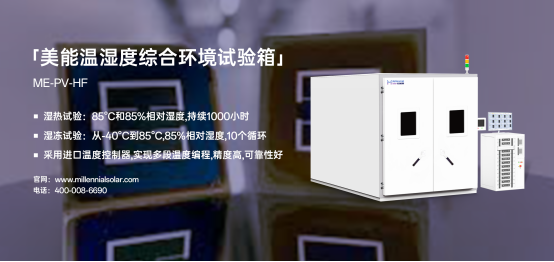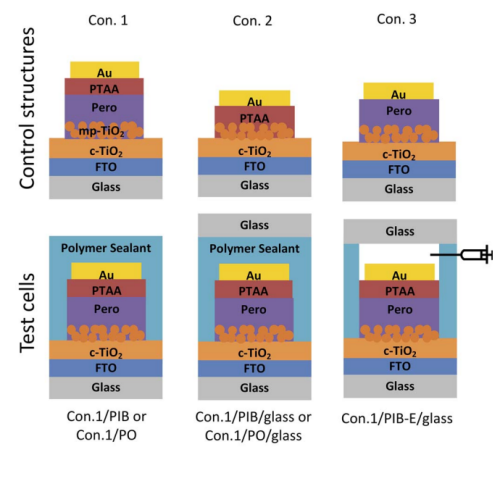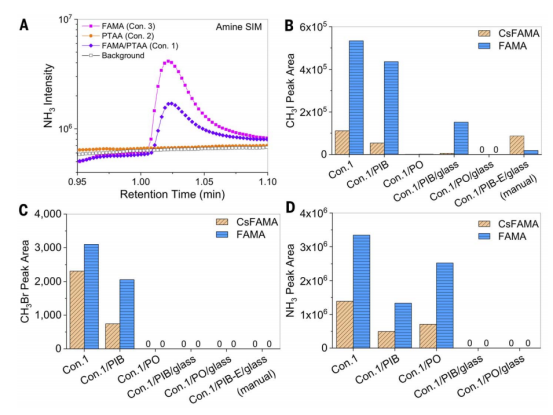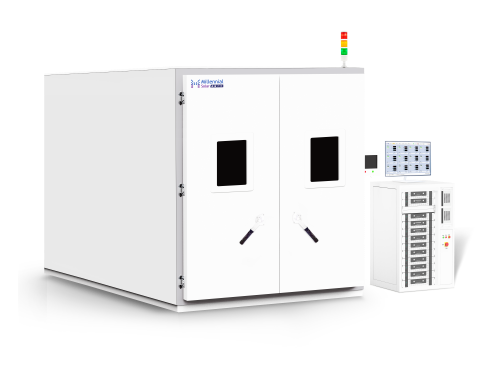
量子效率测试仪
PL/EL一体机
Sinton硅片少子寿命测试仪
Sinton硅块少子寿命测试仪
绒面反射率测试仪
3D共聚焦显微镜
清洗制绒工作站
在线四探针方阻测试仪
全自动扫描四探针方阻测试仪
在线薄膜厚度测试仪
晶化率测试仪
Horiba高速高分辨显微共焦拉曼光谱仪
傅里叶红外光谱仪
霍尔效应测试仪
分光光度计
全光谱椭偏仪
Horiba椭圆偏振光谱仪
TLM接触电阻率测试仪
超景深显微镜
网版智能影像测量仪
全自动影像测量仪
卧式拉力机
电池片稳态光衰老化试验箱
电池片紫外老化试验箱
电池片拉脱力综合测试仪
外观检验台
湿漏电测试系统
组件实验室EL测试仪
紫外老化试验箱
稳态光衰老化试验箱
电流连续性监测系统
PID测试系统
旁路二极管测试系统
LeTID测试系统
反向电流过载系统
脉冲电压测试系统
绝缘耐压测试仪
接地连续性测试仪
绝缘耐压接地测试仪
湿热环境试验箱
湿冻环境试验箱
热循环试验箱
动态机械载荷测试机
静态机械载荷测试机
冰雹冲击试验机
引出端强度试验机
霰弹冲击试验机
抗划伤(切割)测试机
剥离试验机
万能材料试验机(单臂)
万能材料试验机(双臂)
光伏玻璃透过率测试仪
醋酸测试试验箱
交联度测试系统
二极管接线盒综合测试仪
落球冲击试验机
半自动四探针
全自动探针式台阶仪
复合式LED模拟器
多通道太阳能MPPT系统
LED模拟器光浴
Horiba高灵敏一体式稳瞬态荧光光谱仪
钙钛矿P1激光划线测试仪
钙钛矿在线膜厚测试仪
钙钛矿工艺检测工作站
手持式IV测试仪
便携式EL测试仪
手持热成像测试仪
户外组件IV测试仪
户外组件多通道测试系统
光伏逆变器电能质量测试仪
无人机EL检测仪
西南石油大学Science:封装稳定钙钛矿太阳能电池的气相色谱-质谱分析
日期:2024-10-17浏览量:55
钙钛矿太阳能电池(PSCs)的能量转换效率在10年内从3.8%提高到25.2%甚至更高,但它们的商业化受到不稳定性的限制。研究者们开发了一种低成本的聚合物/玻璃堆叠封装方案,使PSCs能够通过IEC 61215标准的湿热和湿度冷冻测试。这些测试通过重复的温度循环(-40°C至85°C)和85%的相对湿度来确定钙钛矿太阳能电池是否能承受户外操作条件的影响。美能温湿度综合环境试验箱用于环境模拟试验,为了验证评估钙钛矿太阳能电池的可靠性,并通过热疲劳诱导失效模式,早期识别制造缺陷。

一种低成本的聚合物/玻璃堆封装方案,使稳定的钙钛矿太阳能电池通过了IEC 61215标准中关于耐湿热和耐冻融的要求。通过气相色谱-质谱法对未封装和封装后的钙钛矿电池进行了分析,检测到在热应力下有机钙钛矿混合体分解的标志性挥发性产物,并证实了所开发的低成本压紧聚合物/玻璃堆封装方案的有效性。

IEC 61215标准的湿热和湿度冷冻测试中的性能变化

封装钙钛矿太阳能电池的结构示意图

IEC 61215 三种测试的具体条件

封装电池的光电转换效率(PCE)随测试时间的变化,包括在湿热测试中的持续时间和在湿度冷冻测试中的循环次数。
湿热测试:模拟了高温和高湿度的环境条件,这对于评估电池在热带气候下的耐久性至关重要。图中显示,PIB宽毯封装的电池在湿热测试中表现出色,而边缘密封的电池性能下降较快。
湿度冷冻测试:结合了湿热和热循环测试,对电池的封装和材料稳定性提出了更高的要求。PIB宽毯封装的电池在75个湿度冷冻循环后没有出现性能退化,远超IEC标准(10个循环)的要求。
使用PIB宽毯封装的钙钛矿太阳能电池在湿热和湿度冷冻测试中表现出优异的稳定性,这对于提高钙钛矿太阳能电池的商业化前景具有重要意义。
不同退火条件下有机钙钛矿前体的分解产物

有机钙钛矿前体在不同退火条件下的分解产物
在不同温度条件下,通过GC-MS技术成功识别了有机钙钛矿前体的主要热分解产物,包括CH3I、CH3Br和NH3等。分解产物的类型和数量随退火温度的不同而变化,表明钙钛矿前体的热稳定性受到温度的显著影响。含有溴(Br)的前体(如MABr)相对于含有碘(I)的前体(如MAI和FAI)更不易于热分解,这可能与Br-的化学性质有关。
对于封装的钙钛矿太阳能电池,封装结构显著降低了分解产物的释放,表明封装可以有效抑制钙钛矿材料的热分解。强调了封装技术在提高钙钛矿太阳能电池热稳定性和耐久性方面的重要性,并为进一步优化封装结构提供了实验依据。
封装对钙钛矿太阳能电池热稳定性的影响

未封装和封装测试电池的示意图
未封装的钙钛矿太阳能电池结构,包括钙钛矿层、空穴传输层(如PTAA)、电子传输层和金属电极等。采用不同封装方法的电池,例如使用聚异丁烯(PIB)或聚烯烃(PO)作为封装材料,以及可能的玻璃覆盖层。

未封装和封装钙钛矿太阳能电池在85°C下退火100小时后的分解产物
未封装结构中某些成分会出现分解产物,而封装可以有效降低分解产物的强度。同时,不同的封装方式(如边缘密封)也有一定的抑制分解产物逸出的效果。此外,通过比较不同细胞(如 CsFAMA 和 FAMA)进一步了解材料成分对热稳定性的影响。对于评估封装方案的有效性以及研究钙钛矿太阳能电池的稳定性具有重要意义。
对于钙钛矿太阳能电池要实现商业化,必须能够忍受长期的环境应力,包括水分、热量和光线等因素的影响。IEC61215的这些测试作为标准的评估手段,是判断钙钛矿太阳能电池是否能够满足商业应用要求的重要依据。
美能温湿度综合环境试验箱

满足标准: IEC61215-MQT12(湿冻试验)、MQT13(湿热试验)
n 湿热试验:85°C和85%相对湿度,持续1000小时
n 湿冻试验:温度循环从-40°C到85°C,85%相对湿度,10个循环
n 采用进口温度控制器,实现多段温度编程,精度高,可靠性好
不同的封装方案对钙钛矿太阳能电池在湿热和湿度冻结试验中的性能表现不同,有效的封装技术对于提高钙钛矿太阳能电池的热稳定性和耐久性至关重要。美能温湿度综合环境试验箱用于环境模拟试验,为了验证评估钙钛矿太阳能电池的可靠性,是判断钙钛矿太阳能电池是否能够满足商业应用要求的重要依据。
原文出处:Gas chromatography–mass spectrometry analyses of encapsulated stableperovskite solar cells,DOI: 10.1126/science.aba2412






































































